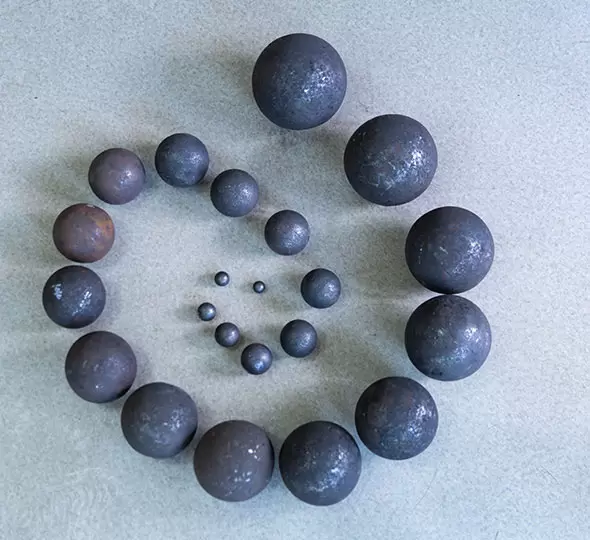In industries such as mining, cement, metallurgy, and electric power, grinding operations are a critical part of the production process. The quality of grinding balls directly affects the crushing efficiency of materials and the operational performance of equipment. As the core component of grinding equipment, hot rolled grinding balls have become a key factor in improving production efficiency and reducing costs due to their excellent wear resistance and hardness. Compared to traditional cast grinding balls, hot rolled grinding balls offer significant advantages in both the manufacturing process and performance, making them widely used in various types of ball mills. This article Longteng will explore the production process and performance characteristics of hot rolled grinding balls in the mining and cement industries.
Hot Rolled Grinding Ball Production Process
The production process of hot rolled grinding balls directly determines their excellent performance. Through advanced techniques, hot rolled grinding balls can achieve a uniform structure and superior mechanical properties, ensuring stable performance under high-intensity wear conditions. The main steps for producing hot rolled grinding balls include heating, roll forming, cooling, and heat treatment. Each step is crucial to the final quality of the grinding balls.
Heating Process: High-Temperature Plasticity Ensures Rolling Formation
The production of hot rolled grinding balls begins with heating the steel billet to a high temperature, usually controlled between 900°C and 1000°C. This heating process is crucial to making the steel billet sufficiently plastic and fluid, allowing the subsequent rolling operations to proceed smoothly. Temperature control is critical during this stage. Excessive heat can cause the steel billet to soften too much, preventing the formation of a dense spherical structure, while insufficient heat can result in inadequate plasticity, affecting the quality of the rolling. Modern production lines often use automated temperature control systems to monitor and adjust furnace temperatures in real time, ensuring consistent heating and setting a strong foundation for subsequent steps.
Roll Forming: High-Precision Mechanical Rolling Ensures the Quality of the Grinding Balls
Once heated, the steel billet undergoes multiple stages of compression and deformation through a rolling mill, which eventually forms it into a spherical shape. During this rolling process, hot rolled grinding balls are subjected to constant pressure, which helps reshape and optimize the internal grain structure of the steel. The metal fibers are aligned along the spherical shape, significantly enhancing the ball's strength and toughness. Unlike the casting process, rolling allows precise control over the shape and size of the grinding balls through mechanical means, ensuring high dimensional accuracy and consistency. The rolling process also eliminates internal pores and micro-cracks in the steel, greatly increasing the density of the ball and reducing the risk of breakage during use.
Cooling and Heat Treatment: Further Optimization of Hardness and Toughness
After rolling, the formed grinding balls remain somewhat plastic due to high temperatures, so proper cooling treatment is necessary. The choice of cooling process significantly affects the final performance of the grinding ball, with methods such as air cooling, water cooling, or spray cooling commonly used. After cooling, the grinding balls undergo heat treatment processes like quenching and tempering. Quenching significantly increases surface hardness, while tempering enhances toughness and impact resistance without sacrificing hardness. This scientifically optimized heat treatment process produces hot rolled grinding balls that maintain excellent wear resistance in high-wear environments and possess sufficient toughness to endure harsh working conditions.
Through multiple processes—heating, rolling, cooling, and heat treatment—hot rolled grinding balls develop a uniform and dense structure, making them highly wear-resistant materials that are widely used in modern industry.
Performance Characteristics of Hot Rolled Grinding Balls
Hot rolled grinding balls are widely used in modern industries due to their exceptional performance. Compared with traditional cast grinding balls, hot rolled grinding balls offer significant advantages in hardness, wear resistance, impact resistance, and dimensional accuracy, making them more effective in grinding operations in industries like mining and cement. These advantages contribute to improved production efficiency and economic benefits. Below are several key performance characteristics of hot rolled grinding balls:
High Hardness: Enhances Grinding Efficiency
Hot rolled grinding balls undergo quenching and heat treatment, achieving hardness levels typically above HRC60, which is much higher than ordinary cast grinding balls. This high hardness allows the grinding balls to better withstand the friction and impact from abrasives and materials in ball mills, resulting in a longer service life. Higher hardness means the grinding balls are less prone to rapid wear, maintaining their effective working volume and shape for longer. This directly improves grinding efficiency because harder grinding balls experience lower wear rates, thus enhancing the performance of ball mills and significantly increasing the material crushing efficiency.
Excellent Wear Resistance: Extends Service Life and Lowers Maintenance Costs
In industries such as mining and cement, grinding balls are exposed to high-wear environments for extended periods. Wear resistance is, therefore, one of the key performance indicators for grinding balls. The rolling process and material selection of hot rolled grinding balls provide excellent wear resistance. Compared with cast grinding balls, the wear rate of hot rolled grinding balls is significantly lower, which extends the service life of the grinding balls. This reduces the frequency of ball replacements and cuts down on maintenance costs. For businesses, this results in lower overall expenses and fewer shutdowns, improving production continuity and cost-effectiveness.
Strong Impact Resistance: Reduces Breakage Rate and Improves Production Stability
In high-intensity grinding environments, grinding balls must not only withstand wear but also endure frequent impact loads. Thanks to the multiple rolling processes and optimized heat treatment, hot rolled grinding balls have a denser and more uniform internal structure, leading to higher impact resistance. In real-world production scenarios, hot rolled grinding balls can effectively resist the strong impact of ore or cement clinker, significantly reducing their breakage rate compared to cast grinding balls. This improvement in impact resistance ensures the ball mill maintains stable grinding performance during long-term high-load operations, reducing the risk of equipment failure or shutdown caused by broken grinding balls.
High Dimensional Accuracy: Improves Equipment Efficiency and Reduces Maintenance
Hot rolled grinding balls achieve strict dimensional accuracy through precision rolling processes. Grinding balls with high dimensional accuracy are more evenly distributed in ball mills, improving the overall operational efficiency of the mills. Additionally, uniformly sized grinding balls reduce friction with the mill's lining and cylinder, thereby minimizing wear on the equipment and lowering maintenance needs. This is especially important for large mines and cement production lines, where the long-term stable operation of equipment is critical for efficient production.
Hot rolled grinding balls play a crucial role in grinding operations in industries like mining and cement due to their high hardness, excellent wear resistance, impact resistance, and precise dimensional accuracy. As a core tool in modern industrial production, hot rolled grinding balls not only improve grinding efficiency and reduce production costs but also significantly extend the lifespan of equipment. As production technology continues to advance, hot rolled grinding balls will remain indispensable in various industries, delivering even higher economic benefits to enterprises.
https://www.lttgsteel.com/Hot-Rolled-and-Hot-Forged-Grinding-Balls/
www.lttgsteel.com
Jiangsu Longteng Special Steel Group





